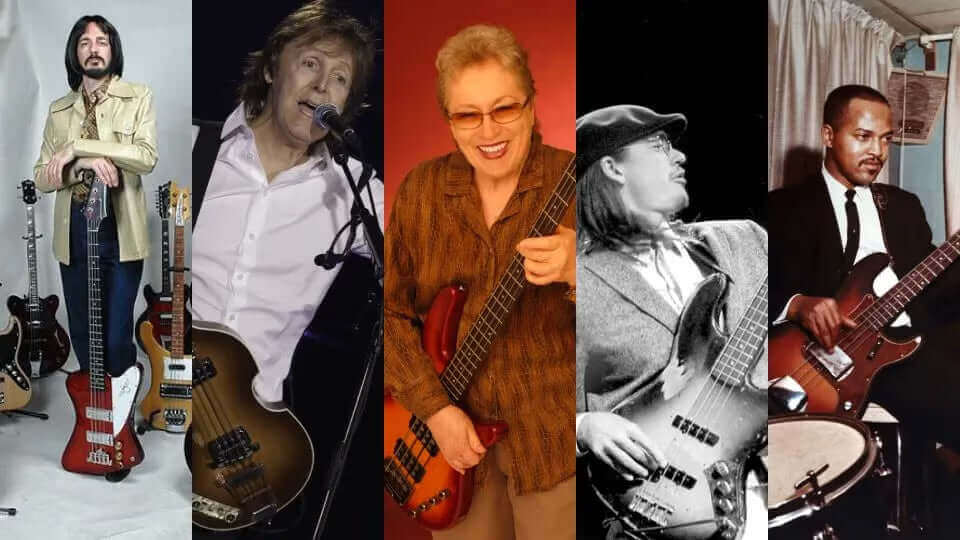
Famous Bass Guitarists: Discover the Best, Most Influential, and Legendary Bass Players of All Time
The bass guitar anchors modern music with rhythm, harmony, and character. This article surveys the most famous bass guitarists to reveal how their styles, techniques, and gear reshaped popular music. Readers will learn who defined rock, funk, soul, and jazz bass vocabulary, which signature instruments produced those tones, and how to translate legendary playing into a practical buying and practice plan. This guide combines biographical insight, technical explanation, and product-aware recommendations to connect famous bass guitar players to real instrument choices and tonal workflows. Many players struggle to identify which model or setup will support a target sound; by mapping players to techniques and instrument attributes, this article provides actionable guidance to bridge inspiration and purchase. The piece proceeds through influential rock bassists, funk and soul pioneers, jazz and fusion virtuosos, a gear-focused breakdown, iconic basslines, a buyer’s decision framework, and a look at notable female bassists shaping the instrument today. Throughout, keywords like famous bass guitarists, iconic bass guitar players, and Jaco Pastorius fretless bass are integrated to aid discovery and to connect readers with the instruments and services that make those sounds possible.
Who Are the Most Influential Bass Guitarists in Rock Music?
Rock music’s most influential bassists redefined the bass role from simple foundation to melodic and rhythmic lead, using tone, technique, and arrangement to drive songs. Their approaches show how instrument choice, amplification, and playing technique produce distinct musical outcomes that performers and producers rely on. Understanding these players clarifies why particular bass models such as Fender Precision or Rickenbacker became genre staples and how modern equivalents can reproduce those tones. The section profiles key rock figures and notes instrument associations so readers can match technique to gear choices when exploring their own sound.
What Made John Entwistle a Rock Bass Legend?
John Entwistle reinvented the bass as a lead instrument by combining a powerful trebly tone with precise fingerwork and independence that cut through dense rock arrangements. His approach relied on complex runs, use of plectrum and finger alternation, and a bright EQ that let bass lines occupy melodic space without clashing with guitars. Entwistle favored Rickenbacker and Fender-style instruments in different eras, and his tonal palette was shaped by aggressive amplification and careful tone sculpting. Players wanting Entwistle-like presence should prioritize pickup clarity and mid/high frequency control, which modern equivalents and certain Rickenbacker-style models recreate.
This profile leads naturally into how progressive rock players used different approaches to expand the bass’s role.
How Did Geddy Lee Shape Progressive Rock Bass Playing?
Geddy Lee combined pick attack, high-register melodic lines, and synth integration to make bass a prominent voice in progressive rock, creating a bright, cutting tone in dense mixes. His multi-instrument role in Rush required instruments and rigs that could project through complex arrangements while retaining clarity, often pairing Fender-style necks with active electronics and effects to broaden sonic possibilities. To emulate Geddy’s tone, players focus on attack, treble emphasis, and compatible amplification settings as much as on instrument choice, and high-output pickup configurations or active preamps approximate that modern sound. Understanding Lee’s role in arrangement points to practice habits and gear setups that prioritize articulation and sonic separation in a band mix.
What Are Lemmy Kilmister’s Signature Bass Techniques?
Lemmy Kilmister treated the bass like a lead guitar, driving heavy rock with relentless plectrum attack, overdriven tone, and rhythmic simplicity that emphasized groove and aggression. His approach used heavy strings, high output, and often unconventional tuning and rigs to achieve a guitar-like presence, and many modern hard-rock players learn from his economy of notes and powerful timing. Instrument-wise, short-scale or specially set-up basses that can tolerate low tunings and aggressive attack are useful for approximating Lemmy’s tone, and amp saturation plus gritty overdrive pedals complete the sound chain. This practical view of technique and gear demonstrates how genre-specific demands shape instrument selection and setup.
Which Bass Guitars Did John Paul Jones Use with Led Zeppelin?
John Paul Jones blended melodic sensibility, orchestral arrangement, and tonal control, using a range of instruments including Fender and custom models to match Led Zeppelin’s dynamic arrangements and diverse song textures. His tone alternated between warm, round low end for ballads and more articulate, mid-forward voices for driving rock parts, achieved through pickup choice, string gauge, and careful amplification. Modern players seeking Jones’s versatility benefit from instruments with flexible pickup configurations and comfortable neck profiles that accommodate both fingerstyle grooves and more treble-focused passages. Examining Jones’s setup makes clear how a single bassist can serve songcraft across contrasting styles, which informs the choice of a go-to instrument for studio and stage work.
Which Funk and Soul Bassists Revolutionized Bass Playing?
Funk and soul bassists transformed the instrument through rhythmic invention, groove-oriented phrasing, and new techniques like slap and ghost notes that reshaped popular music’s pocket. Their work demonstrates how technique creates signature grooves and how instrument features neck profile, pickup placement, and string choice support syncopated, percussive playing. This section profiles Motown and funk pioneers and explains the playing mechanics that students should prioritize when learning those styles.
Why Is James Jamerson Considered the Motown Bass Genius?
James Jamerson defined the Motown sound with melodic, syncopated lines played on a Fender Precision Bass that fused rhythmic drive with harmonic creativity, often recorded with an almost vocal-like phrasing. His technique emphasized fingerstyle groove, tasteful use of chromatic passing notes, and subtle dynamics that enhanced song narratives without overpowering them, and the Fender Precision’s warm punch was central to that voice. Musicians seeking Jamerson’s sound focus on finger positioning, low-action setups, and medium-gauge flatwound or roundwound strings that balance warmth with articulation—attributes found on modern Precision-style instruments. Studying Jamerson’s pocket leads into how funk’s flamboyant players extended bass vocabulary through stagecraft and new techniques.
How Did Bootsy Collins Define Funk Bass Style?
Bootsy Collins combined showmanship with percussive playing and rhythmic motifs, using distinctive instrument shapes and effects to make the bass both a sonic and visual focal point in funk. His use of space, syncopation, and heavy emphasis on the one transformed audience expectations of the bassist’s role, and his gear choices often custom, star-shaped basses with bright electronics supported a buoyant, pronounced tone. Players inspired by Bootsy should prioritize slap-friendly necks, punchy bridge pickup settings, and expressive effects, while practicing groove displacement and call-and-response phrasing. This exploration of Bootsy’s approach opens into the technical origin and spread of slap bass.
Who Invented Slap Bass and How Did Larry Graham Influence It?
Larry Graham is credited with inventing slap bass to emulate percussive ensemble roles, using thumb thumps and finger pops to create a drum-like rhythmic foundation and introducing a highly percussive articulation to popular music. The mechanics of slap/pop require a responsive neck, sturdy action, and strings that allow aggressive attack without buzzing, and many modern bass designs cater to slap technique with flatter fingerboards and lower action. For learners, beginning with consistent thumb position and isolated pop practice builds the necessary coordination, and selecting a slap-friendly instrument supports faster technical progress. Understanding slap’s origins illuminates how technique and instrument design evolved together in funk and beyond.
Who Are the Jazz and Fusion Bass Virtuosos Changing the Game?
Jazz and fusion bass virtuosos expanded harmonic, melodic, and technical possibilities on the bass, introducing fretless expression, harmonics, tapping, and advanced rhythmic interplay that reshaped expectations for melodic bass playing. Their innovations demonstrate how instrument choices - fretless fingerboards, active electronics, and precise setup enable nuanced pitch control and dynamic color. This section highlights key innovators and points to gear and practice approaches that help modern players adopt advanced techniques and musical roles.
What Innovations Did Jaco Pastorius Bring to Fretless Bass?
Jaco Pastorius popularized the fretless electric bass as a lyrical, vocal-like instrument, using precise intonation, natural harmonics, and melodic soloing to create a new expressive vocabulary on a fretless fingerboard. His technique relied on careful fingering, carefully chosen string gauges, and a lightly set-up action to enable glissando and microtonal inflection, and his famous use of a fretless Fender-style bass reshaped expectations for melody and timbre on electric bass. Players exploring fretless work should prioritize ear training, sustained legato technique, and instruments that offer stable tuning and resonant tone, while practicing harmonics and slide control to reproduce Jaco’s signature colors. Jaco’s innovations lead into how modern pedagogy incorporates his melodic approach.
How Does Victor Wooten’s Modern Bass Technique Inspire Players?
Victor Wooten blends double-thumbing, controlled slap, tapping, and melodic phrasing with a rhythmic sensibility that treats the bass as both groove engine and lead voice, and his pedagogical approach stresses musicality and independence. His technique benefits from instruments with fast necks, responsive midrange, and clear note definition, plus setups that support rapid thumb and finger motion without fret buzz or intonation issues. For students, Wooten’s exercises emphasize rhythm subdivision, coordination drills, and musical phrasing to apply technique within song contexts, and appropriate instrument selection accelerates technical gains. Victor’s modern approach points to the interplay between practice, instrument ergonomics, and expressive range.
What Are Stanley Clarke’s Contributions to Jazz Fusion Bass?
Stanley Clarke brought solo performance and virtuosic technique to the forefront of jazz fusion, demonstrating that the bass can function as a melodic lead through nimble fingerwork, compositional depth, and use of acoustic and electric timbres. His frequent alternation between upright and electric bass showcased the instrument’s range and encouraged players to develop both pizzicato strength and electric articulation, while his use of active electronics and expressive phrasing expanded sonic possibilities. Musicians emulating Clarke focus on versatility across instruments, dynamic control, and a balance between technical showmanship and musical storytelling, which in turn influences choices about pickups, preamps, and string types. Clarke’s career illustrates how genre-crossing techniques inform modern bass pedagogy and gear selection.
What Are the Signature Styles and Gear of Iconic Bass Guitarists?
Signature styles and gear explain how a player’s technique, instrument model, and amplification chain produce a recognizable sound; connecting these elements helps players match a target tone to an instrument and setup. The following mini-comparisons show artist-model associations and how those models affect playability and tone, enabling readers to identify specific attributes to prioritize when seeking a particular sound. After this technical mapping, a concise table links bassists to the models that shaped their signature tones to support informed shopping decisions.
Different bassists favor particular models because those instruments provide specific tonal fingerprints and playability features.
| Bassist | Signature Instrument | Typical Instrument Traits |
|---|---|---|
| Paul McCartney | Hofner/short-scale bass model | Warm, woody tone; easy upper-register melodic playing |
| Flea | Fender Jazz Bass (and variations) | Bright, punchy midrange; fast neck for slap and fingerstyle |
| Jaco Pastorius | Fretless Fender-style bass | Singing harmonics, smooth slides, fretless expressiveness |
This table clarifies how instrument traits lead directly to perceived tonal identity and helps readers prioritize features in their search for similar models. Understanding these associations leads naturally into technique-specific gear choices like pickups, action, and amplification.
When discussing instruments and amplifiers associated with these artists, note that MusicStreet in Huntingdon, Cambridgeshire stocks many relevant brands and models, including Fender, MusicMan, and Rickenbacker, with new and pre-owned options and workshop setups available. Their hand-selection process and in-house setup service help players receive a playable instrument tuned to their stylistic needs, and free UK shipping plus part-exchange options make trying equivalent models practical for UK-based players. These retailer services connect the gear-focused insights above with concrete, local purchasing and setup support.
Which Bass Guitars Are Favored by Paul McCartney and Flea?
Paul McCartney’s Hofner-style short-scale basses prioritize warmth and ease of melodic phrasing, whereas Flea’s Fender Jazz-style approach maximizes attack and fingerboard speed for funk and rock. The Hofner’s thin body and short scale reduce tension for bends and melodic lines, and the Jazz Bass’s offset waist and dual single-coil pickups provide clarity and slap responsiveness. Players deciding between these models should assess scale preference, neck profile, and pickup voicing to match their focal techniques and genre goals. Choosing the right model often requires trying both body shapes and pickup configurations to find the best ergonomic and tonal fit.
How Do Famous Bassists Use Techniques Like Slap, Tapping, and Fingerstyle?
Slap emphasizes rhythm with percussive thumb strikes and finger pops to create a drum-like role, tapping uses both hands on the fretboard to produce rapid melodic lines and harmonics, while fingerstyle prioritizes dynamic control and sustained tonal nuance for grooves and melodic support. Each technique imposes setup requirements - slap benefits from low action and sturdy bridges, tapping needs neck stability and clear note definition, and fingerstyle gains from balanced pickup response and comfortable string spacing. Practicing technique-specific drills while adjusting instrument setup enables players to integrate those methods into musical contexts and to select models that facilitate long-term technical development.
What Amplifiers and Effects Define Legendary Bass Sounds?
Iconic bass tones often pair classic amplifiers with selective effects: tube or solid-state heads set core gain and headroom while compressors, octave pedals, and overdrive shape character and presence. Different genres favor different amp brands and settings—clean, high-headroom amps for jazz and warm saturated heads for rock - while effects like envelope filters and octave-up pedals are staples in funk and modern alternative tones. Selecting compatible amp power, speaker configuration, and effect order helps replicate a target sound and preserves instrument dynamics, and experimenting with EQ, compression, and signal chain placement is essential to translate an instrument’s raw voice into a finished band sound. Understanding these amp and effect roles completes the link between player technique and final recorded or live tone.
What Are the Greatest Basslines Ever Played by Famous Bassists?
Great basslines stand out because they combine melodic identity, groove, and arrangement purpose; analyzing them reveals technique, note choices, and tone-shaping that musicians can study to improve their craft. This section selects representative basslines across genres and explains why each is significant, offering teaching cues and the gear contexts that produced the recorded sounds.
The following table maps songs to technique highlights and gear used to clarify practical learning objectives for players.
| Song / Bassline | Technique Highlighted | Why It’s Significant |
|---|---|---|
| Motown grooves (various Jamerson lines) | Fingerstyle syncopation, ghost notes | Demonstrates pocket, melodic creativity within pop structures |
| Funk staples (Bootsy/Larry Graham lines) | Slap/pop, rhythmic displacement | Reimagined bass as percussive lead and groove driver |
| Fusion solos (Jaco lines) | Fretless harmonics, melodic soloing | Expanded bass into a lyrical, horn-like solo voice |
This mapping helps learners focus on specific techniques and the instrument attributes that facilitate them, and studying these lines suggests practice priorities to achieve similar musical impact.
Which Basslines Made Chris Squire and Geezer Butler Stand Out?
Chris Squire and Geezer Butler crafted basslines that functioned as melodic and harmonic anchors with distinct tonal personalities: Squire’s bright, chorus-tinged Rickenbacker sound cut through progressive mixes, while Geezer used heavy, overdriven tones to anchor metal dynamics. Their lines are notable for intervallic movement, strategic use of tone coloration, and role in song arrangement, and both players demonstrate how bass can occupy both rhythmic and melodic space simultaneously. Emulating these lines requires attention to pickup choice, tonal sculpting, and rhythmic precision, which guides instrument and amp decisions for players seeking similar presence in a band mix.
What Are the Most Recognizable Funk and Soul Basslines?
Funk and soul basslines are immediately identifiable because they combine syncopated rhythm, ghost notes, and rhythmic hooks that lock with drums to create a danceable pocket, often relying on concise motifs repeated with subtle variation. Learning these lines improves a player’s feel, timing, and dynamic control, and practicing with metronome subdivisions and attention to micro-dynamics captures the nuance that makes these lines groove. Instrument-wise, players should choose setups that preserve percussive definition and midrange clarity to ensure the groove translates across recording and live contexts.
How Have Jazz and Fusion Basslines Influenced Modern Music?
Jazz and fusion basslines introduced complex phrasing, harmonic sophistication, and melodic independence that now inform session work and modern songwriting, encouraging bassists to think beyond root motion and contribute countermelodies and texture. Contemporary genres borrow these approaches for richer arrangements, with session bassists expected to provide harmonic lines, melodic fills, and stylistic adaptability. Gear that supports articulate note definition, dynamic responsiveness, and versatile EQ helps modern players translate jazz/fusion skills into pop, indie, and film work, and understanding these cross-genre influences shows how advanced techniques expand employment opportunities for bassists.
How Can You Choose the Best Bass Guitar Inspired by Legendary Players?
Choosing a bass inspired by a legend requires mapping the player’s technique and sonic goals to instrument attributes like scale length, pickup type, and electronics, and prioritizing ergonomic comfort for long practice and performance sessions. A short decision framework helps buyers match needs to characteristics: define target sound and playing style, select scale and string count, choose pickups/electronics to suit tone, and budget for setup and servicing. Below is a simple decision guide that converts musical inspiration into practical selection steps and sample model recommendations based on common player archetypes.
Follow these steps to translate inspiration into a buying decision:
- Identify Your Primary Style: Choose whether rhythm, lead, slap, or melodic soloing is your focus to determine pickup and neck requirements.
- Match Scale and Strings: Decide between short-scale for ease of play and 4/5/6-string options for range based on repertoire needs.
- Prioritize Electronics and Setup: Choose active pickups for clarity and modern funk or passive pickups for vintage warmth, then arrange for a professional setup to optimize action and intonation.
| Playing Style | Recommended Bass Type | Example Attributes |
|---|---|---|
| Motown / session | Fender Precision-style | Warm split-coil pickup, medium action, balanced mids |
| Funk / slap | MusicMan / Jazz-style | Punchy bridge pickup, fast neck, active electronics |
| Fretless / melodic | Fretless Jazz-style | Smooth fingerboard, medium-light strings, precise setup |
This comparison maps playing goals to instrument types and highlights technical features players should prioritize; it prepares buyers to test models that match their musical ambitions.
What Are the Top Fender and MusicMan Bass Models Used by Famous Bassists?
Fender Precision and Jazz Bass models plus MusicMan StingRay-style instruments are repeatedly chosen by top players because they each supply specific tonal foundations: Precision for focused low-mid warmth, Jazz for versatile dual-pickup clarity, and MusicMan Bass for punchy mid-forward presence and active electronics. Famous players associated with these models demonstrate how pickup configuration and neck profile inform genre suitability and technique execution. When testing instruments, players should compare pickup voicing, neck comfort, and how each model responds to their preferred playing dynamics to determine the best fit for their style.
How Do Different Bass Guitar Types Suit Various Playing Styles?
Four-string fretted basses offer straightforward learning and strong foundational groove for most genres, five and six-strings extend range for modern arrangements and solo work, while fretless instruments enable microtonal expression and singing lines. Active electronics favor slap and modern clarity, whereas passive circuits suit vintage warmth and recording contexts where natural compression is desired. This comparison helps players weigh trade-offs between range, tonal versatility, and technique compatibility to select an instrument that supports their immediate musical goals and long-term development.
Where Can You Find High-Quality Bass Guitars and Accessories at MusicStreet?
MusicStreet, based in Huntingdon, Cambridgeshire, operates as a premium UK guitar shop with a curated selection of new and pre-owned bass guitars, amplifiers, and accessories from brands such as Fender, MusicMan, and Rickenbacker. Their workshop hand-sets up each instrument, and services include meticulous setups, servicing, repairs, and part-exchange to ensure instruments arrive playable and tailored to the customer’s needs. For UK buyers seeking practical purchase options, MusicStreet emphasizes fast free UK shipping and trade-in options that make trying different models accessible, and their expert staff provide guidance to match player goals with specific models and setups.
Who Are the Rising and Famous Female Bass Guitarists to Know?
Female bassists have made foundational and contemporary contributions to bass culture both historically and in modern scenes, bringing session expertise, stylistic innovation, and visibility to the instrument. This final section spotlights session pioneers and contemporary players who influence technique, representation, and pedagogy, and it suggests instrument choices and services for aspiring players of all levels. Highlighting these artists demonstrates the breadth of bass roles across studio, live, and educational contexts and points to practical steps for players seeking similar career paths.
What Impact Has Carole Kaye Had as a Session Bass Legend?
Carole Kaye’s extensive session work established standards for melodic, supportive bass playing in studio contexts, favoring clear tone, impeccable timing, and lines that complement arrangement without dominating mixes. Her approach emphasized economy of motion, harmonic inventiveness and consistent rhythmic placement - skills that define session professionalism and are transferable across genres. Players aiming for session work should prioritize reliability, tone control, and a comfortable instrument that yields consistent intonation, and they should consider setups that reproduce Kaye-style clarity for recording environments. Understanding Kaye’s contributions leads into profiles of contemporary female bassists continuing this legacy.
Which Contemporary Female Bassists Are Shaping Modern Music?
Contemporary female bassists bring diverse stylistic approaches to modern music, from groove-oriented session players to virtuoso soloists, and they influence pedagogy, representation, and instrument design preferences. Their influence encourages inclusive band dynamics and demonstrates that technique and musical leadership are gender-neutral competencies, while their use of varied gear reinforces the idea that instrument choice must match artistic intent. Aspiring players should study contemporary performances, prioritize instruments that support their stylistic goals, and take advantage of services like professional setups and trade-in options to refine their sound and stage readiness.
- Notable contemporary players model diverse approaches to tone and technique.
- Instrument selection should reflect repertoire demands and ergonomic comfort.
- Workshop services and part-exchange can accelerate access to suitable instruments.
These practical points summarize how studying female bassists informs both artistic direction and purchase strategy, and they encourage readers to apply the earlier buying framework to their own development.




Share:
How to Read Guitar Tabs (Beginner’s Step‑by‑Step Guide)
What Is Overdrive? Complete Guide for Guitarists